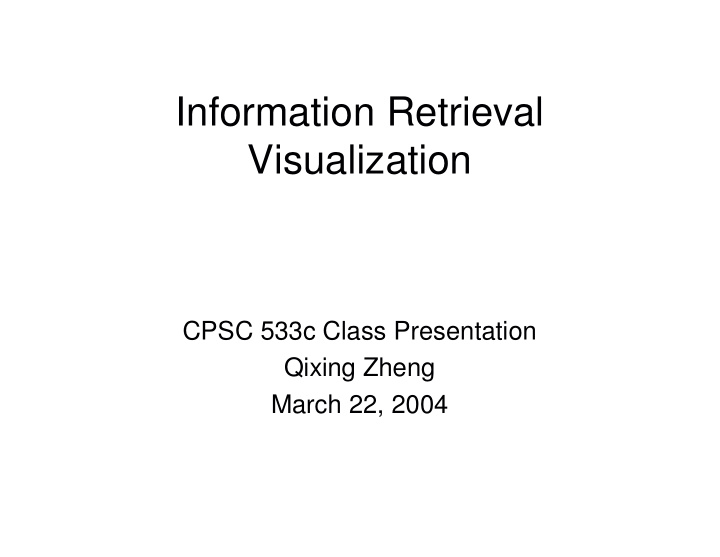



Information Retrieval Visualization CPSC 533c Class Presentation Qixing Zheng March 22, 2004
Purpose of Information Retrieval (IR) “The purpose of information retrieval is to help users effectively access large collections of objects with the goal of satisfying users’ stated information needs.” -- W. Bruce Croft
Too Few or Too Many • Your Search: {collaborative};{visualization};{tool} Search Results: Records found: 2 / Total characters: 5667 • Your Search: {collaborative,visualization,tool} Search Results: Records found: 3213 / Total characters: 4000286
The Search Results…
Outline • Background on IR • InfoCrystal (Spoerri, 1993) • TileBars (Hearst, 1995) • Evaluation of a Tool for Visualization of Information Retrieval Results (Veerasamy & Belkin, 1996)
Background on IR • Common approaches of text retrieval – Boolean term specification e.g. information retrieval AND (query language OR human factors) – Similarity search: vector space model, probabilistic models, and etc. Rank documents according to how close they are to the terms in the query
Functionalities of IR Visualization Systems Relationships Generating Query terms between queries and Boolean Queries distribution in retrieved documents the document Frequency of Keyword-based / Search support query terms Full text Transparency of Providing Document Ranking overview of query length words in the document space
Outline • Background on IR • InfoCrystal (Spoerri, 1993) • TileBars (Hearst, 1995) • Evaluation of a Tool for Visualization of Information Retrieval Results (Veerasamy & Belkin, 1996)
InfoCrystal Formation Shape Rank coding Orientation coding coding Proximity Color or texture Size or Brightness coding coding &saturation coding
InfoCrystal Numbers indicate the amount of documents retrieved Ranking vs. proximity principle Users can select relationships by clicking icons The threshold slider
Features of InfoCrystal • A visualization tool and a visual query language • Visualize all the possible discrete and continuous relationships among N concepts • User can selectively emphasize the qualitative or the quantitative information • Users can specify Boolean and vector-space queries graphically
Functionality Check Relationships Generating Query terms between queries and Boolean Queries distribution in retrieved documents the document Frequency of Keyword-based / Search support query terms Full text Transparency of Providing Document Ranking overview of query length words in the document space
Critique • Pros • Cons – Very smart idea – No user studies to test the effectiveness of the visualization – Nice comparison with relevant previous work – Concentrate on the short comings all other systems
Outline • Background on IR • InfoCrystal (Spoerri, 1993) • TileBars (Hearst, 1995) • Evaluation of a Tool for Visualization of Information Retrieval Results (Veerasamy & Belkin, 1996)
TileBars Three Term sets Large rectangle indicates a document Click on a tile to see the contents of the document. Term frequency and distribution information is important for determining relevance.
Functionality Check Relationships Generating Query terms between queries and Boolean Queries distribution in retrieved documents the document Frequency of Keyword-based / Search support query terms Full text Transparency of Providing Document Ranking overview of query length words in the document space
Critique • Pros • Cons – One of the first paper – No user studies to test focused on long texts the effectiveness of information access the visualization – Provides information – Good for long text on how different query retrieval, constrained facets overlap in by length different sections of a long document
Outline • Background on IR • InfoCrystal (Spoerri, 1993) • TileBars (Hearst, 1995) • Evaluation of a Tool for Visualization of Information Retrieval Results (Veerasamy & Belkin, 1996)
Another IR Visualization
Metrics for Evaluation • Test effectiveness, usability, and acceptability of the visualization tool • Prediction: the visualization tool will make better decisions about which documents to look at than those without visualization • Parameters: – # of documents saved per search (s-p-s) – Interactive trec precision (i-t-p) – Interactive user precision (i-u-p) – Precision of the seach
Experiment 1 • 36 subjects, 3 groups – Group “with-out: with” initial tutorial, 1 st search without visualization, intermediate • tutorial, 2 nd search with visualization tool – Group with: with – Group without: without • Results – No significant differences between any two groups in any of the four measures
Experiment 2 • 36 subjects, 2 groups – Group “viz” – Group “noviz” • Results – Favor “viz” group, but not significant – One explanation: visualization of this sort is helpful for naïve searchers, but loses its effect when users become more experienced with the IR system
Critique • Pros • Cons – Initial attempt to – Many confounds in the evaluate visualization experiment tool for IR – No user feedback was – Generate possible reported metrics for evaluation – Did not state why the authors decided to choose the particular vis tool to evaluate
Conclusion • How can we use visualization to help us to filter the huge information collection? • What are the key features that make a IR visualization useful? • How can we design better user studies to test these systems? • Would the combination of IR visualization tools and IR intelligent agents be more powerful, and can assists users better?
Recommend
More recommend